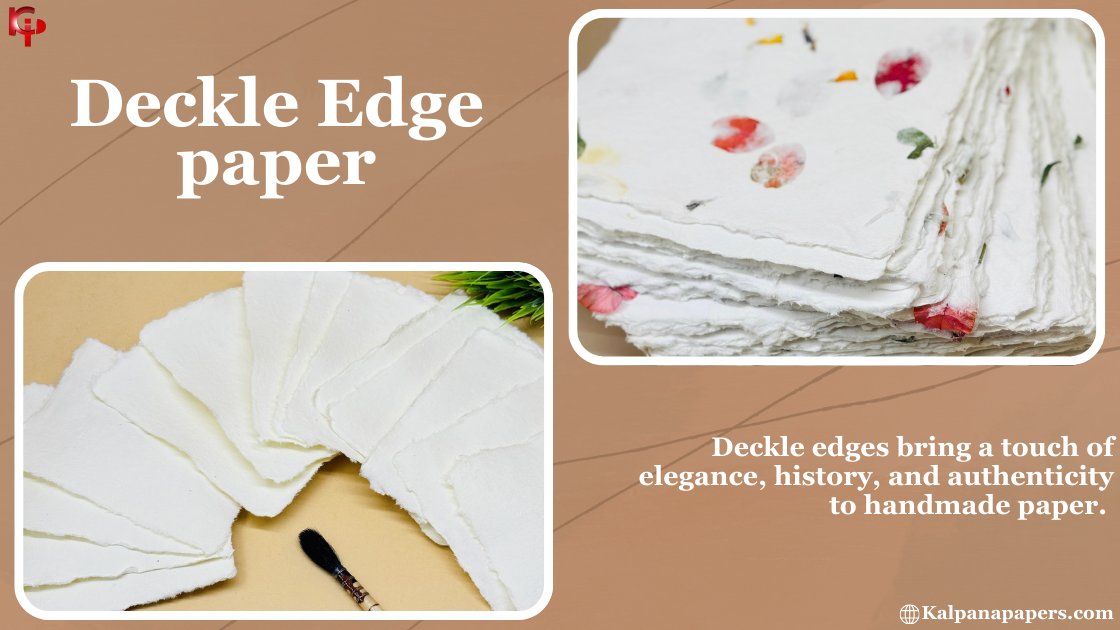19-Feb-2025 by
Deckle Edge PaperDeckle Edges in Handmade Paper: A Guide to Vintage Aesthetics
Handmade paper has been admired for centuries due to its unique texture, durability, and artistic appeal. One of the most distinguished characteristics of handmade paper is its deckle edges, which give it an organic, vintage look. These naturally rough, uneven edges add a sense of authenticity and elegance, making deckle edge paper a preferred choice for artists, calligraphers, and stationery enthusiasts.
What Are Deckle Edges?
A deckle edge is the naturally frayed, irregular border that forms on handmade paper during the papermaking process. Unlike machine-made paper, which has a uniform, straight edges, deckle edges create a rustic and artistic appearance that enhances the overall aesthetic appeal of the paper.
The History of Deckle Edge Paper
Deckle edges date back to the earliest days of papermaking when artisans manually crafted sheets using wooden frames called deckles. The deckle would allow excess pulp and water to escape, leaving behind uneven, feathered edges. In modern times, these edges have become synonymous with vintage aesthetics and high-quality craftsmanship.
Why Choose Handmade Paper with Deckle Edges?
Handmade paper, particularly cotton paper and English cotton paper, is known for its rich texture and longevity. When combined with deckle edges, the paper exudes an unmatched charm, making it ideal for:
- Wedding invitations
- Art prints and watercolour paintings
- Luxury stationery
- Bookbinding
- Calligraphy and journaling
How Handmade Paper is Created
To understand deckle edges, it's essential to explore how handmade from paper is crafted. The process involves several meticulous steps:
1. Pulp Preparation: Natural fibres such as cotton, linen, or recycled paper are broken down into a pulp.
2. Sheet Formation: The pulp is poured onto a screen framed by a deckle.
3. Pressing and Drying: Excess water is drained, and the sheets are dried to maintain durability.
4. Deckle Edge Formation: Since the frame restricts the spread of fibres, excess pulp collects around the edges, forming the characteristic uneven look.
The Appeal of English Cotton Paper
English cotton paper is renowned for its exceptional quality, soft texture, and durability. Because it is made from high-grade cotton fibres, it offers superior absorbency and a smooth surface, making it perfect for writing and printing. The delicate edges of English cotton paper enhance its luxurious feel, making it a top choice for high-end invitations and artistic creations.
How to Use Deckle Edge Paper Creatively
1. Calligraphy and Letter Writing
The rough yet elegant edges of deckle edge paper add a personal touch to handwritten notes, making them feel timeless and unique.
2. Wedding Invitations and Event Stationery
Couples looking for a vintage or rustic wedding theme often choose deckle edge invitations for their romantic and old-world charm.
3. Art and Illustrations
Artists love deckle edges for their ability to enhance watercolour paintings, charcoal sketches, and fine art prints.
4. Bookbinding and Journals
Many luxury journals and limited-edition books feature the deckle edge, adding to their antique and artisanal appeal.
How to Achieve a Deckle Edge Effect at Home
While naturally formed deckle edges are the most authentic, you can also create a similar effect at home:
- Hand-Tearing Method: Slightly dampen the paper and tear it along a ruler for a soft, fibrous edge.
- Deckle Scissors: Specialized scissors mimic the organic look of deckle edges.
- Deckle Edge Rulers: These allow you to tear paper in a controlled way while achieving a vintage effect.
Preserving and Storing Deckle Edge Paper
To maintain the beauty of deckle edge paper, follow these care tips:
- Store in a dry, cool place to prevent warping.
- Use acid-free folders to protect against discolouration.
- Handle with clean, dry hands to avoid smudging or stains.
Conclusion
Deckle edges bring a touch of elegance, history, and authenticity to handmade paper. Whether you are an artist, a calligrapher, or someone who appreciates fine stationery, incorporating deckle edge paper into your projects can elevate the aesthetic and artistic value of your work. With a rich tradition dating back centuries, the deckle edge remains a beloved feature of handmade and English cotton paper, offering timeless appeal in a modern world.

